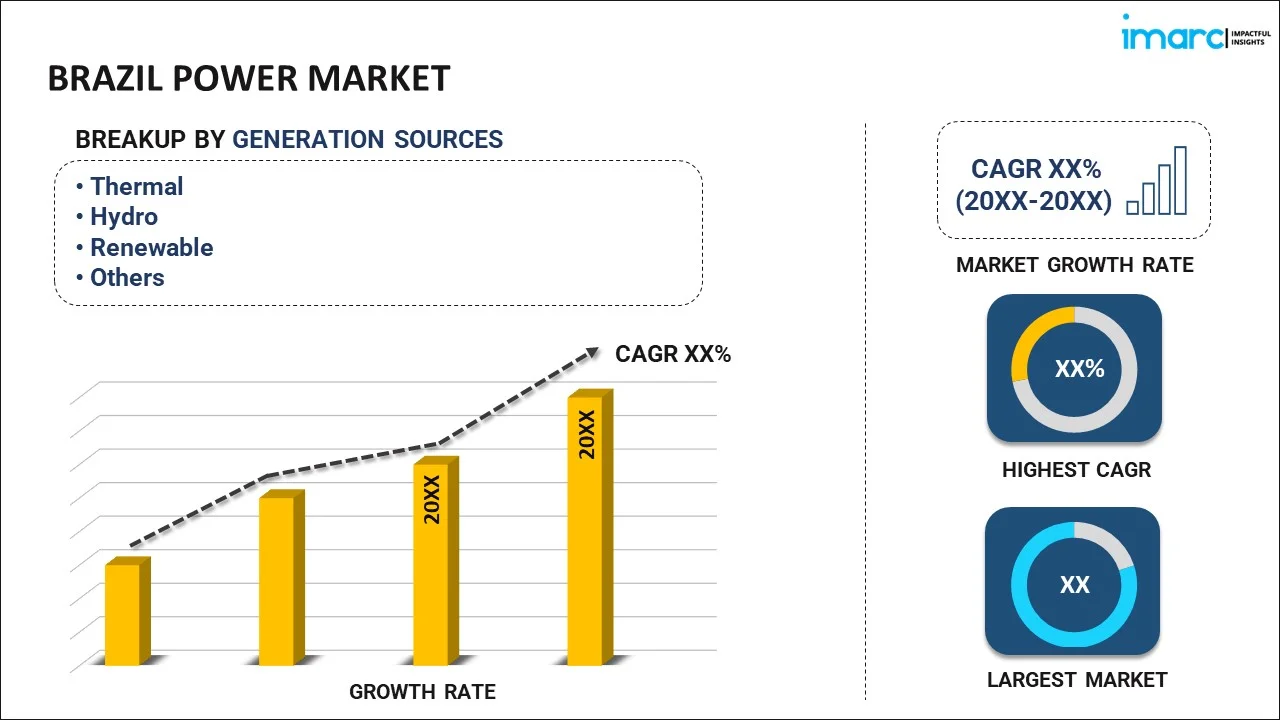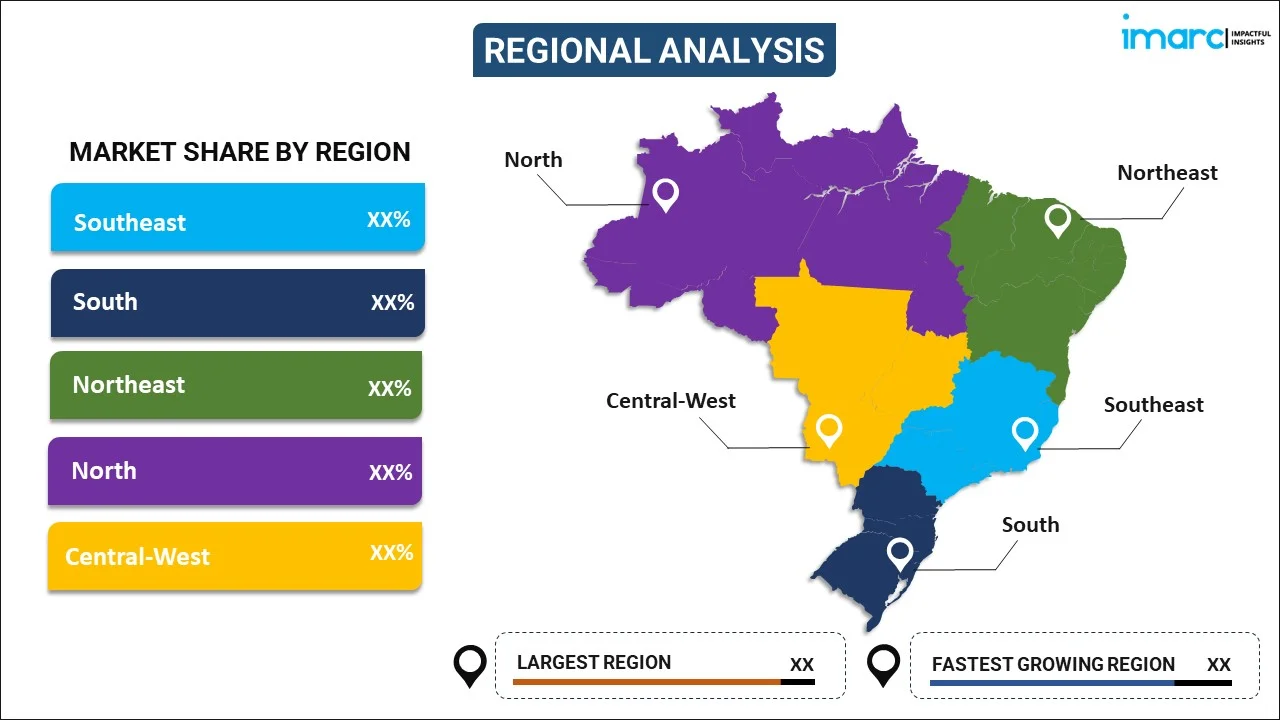
Brazil Power Market Report by Generation Source (Thermal, Hydro, Renewable, and Others), and Region 2024-2032
Brazil Power Market:
Brazil power market size is projected to exhibit a growth rate (CAGR) of 6.53% during 2024-2032. The growing emphasis on renewable energy sources, the increasing modernization of the grid infrastructure, and the aging power grids leading to inefficiencies, power losses, and reliability issues represent some of the key factors driving the market.
|
Report Attribute
|
Key Statistics
|
|---|---|
|
Base Year
|
2023 |
|
Forecast Years
|
2024-2032
|
|
Historical Years
|
2018-2023
|
| Market Growth Rate (2024-2032) | 6.53% |
Brazil Power Market Analysis:
- Major Market Drivers: One of the primary drivers of change in the Brazilian power market is the growing emphasis on renewable energy sources. Moreover, the shift towards renewables aligns with global sustainability goals and has attracted investments from both domestic and international players, further propelling the Brazil power market demand.
- Key Market Trends: The growing modernization of the grid infrastructure is escalating the market growth. Additionally, the industrial expansion, urbanization, and a rising middle-class population is also driving the expansion of the industry's demand.
- Competitive Landscape: The Brazil power market analysis report has also provided a comprehensive analysis of the competitive landscape in the market. Also, detailed profiles of all major companies have been provided.
- Geographical Trends: The large urban population and commercial activities in the Southeast region create substantial demand for electricity. High-rise buildings, shopping centers, and office spaces all contribute to significant power consumption. Moreover, industrial facilities and agricultural operations, including food processing and manufacturing, drive power demand in the South region.
- Challenges and Opportunities: The aging infrastructure and volatility in global energy prices are hampering the market's growth. However, the development of energy storage solutions, such as batteries and pumped hydro storage, can help manage intermittency in renewable energy sources and improve grid stability.
Brazil Power Market Trends:
Renewable Energy Expansion
Brazil has invested heavily in renewable energy sources, particularly hydroelectric power, wind, and solar energy. For instance, according to Statista, in 2023, investments in renewable energy technology in Brazil totaled around US$ 25.5 billion. The country’s vast natural resources and favorable climatic conditions for these technologies have driven substantial growth in the sector. These factors further positively influence the Brazil’s power market forecast.
Growing Environmental Concerns
The growing awareness of environmental issues and climate change has led to a shift towards cleaner energy sources. Brazil’s commitment to reducing greenhouse gas emissions and promoting sustainable energy practices has spurred growth in the renewable energy sector. For instance, Brazil amended its NDC in March 2022, committing to decreasing GHG emissions by 37% by 2025 and 50% by 2030, compared to 2005. Brazil's obligations include a long-term goal of attaining climate neutrality by 2050 (down from 2060 in the 2020 NDC). These factors are further contributing to the Brazil power market share.
Expansion of Hydropower Industry
The growth of the hydropower industry is a significant driver for Brazil's power market. Brazil has a long history of investing in hydropower due to its abundant water resources and the natural geography that supports large-scale hydroelectric projects. Brazilian government policies and incentives have historically favored hydropower development. Investments in infrastructure and favorable regulatory frameworks support the growth of this sector. For instance, as of 2022, Brazil had approximately 195 MW of hydroelectric projects expected to begin commercial operations that year, including Elera Renováveis' Foz do Estrela small hydro plant. Furthermore, the government has set an ambitious goal of achieving a hydroelectric capacity of 112.5 GW by 2030. These factors are augmenting the Brazil power market growth.
Brazil Power Market Segmentation:
IMARC Group provides an analysis of the key trends in each segment of the market, along with forecasts at the country and regional levels for 2024-2032. Our report has categorized the market based on generation source.
Breakup by Generation Source:

- Thermal
- Hydro
- Renewable
- Others
The report has provided a detailed breakup and analysis of the market based on the generation source. This includes thermal, hydro, renewable, and others.
According to the Brazil power market outlook, hydropower is one of the prominent sources of electricity in Brazil. The country's geography and ample water resources make it ideal for hydroelectric dams. Hydropower accounts for a substantial portion of Brazil's electricity supply. Moreover, Brazil is investing in various renewable energy sources. It has significant potential for wind energy, especially in coastal regions. Wind farms are becoming a more substantial part of the energy mix. Solar energy is growing rapidly in Brazil, based on its sunny climate. Solar farms and distributed solar generation (rooftop panels) are expanding. These factors are further driving the market’s growth.
Breakup by Region:

- Southeast
- South
- Northeast
- North
- Central-West
The report has also provided a comprehensive analysis of all the major regional markets, which include Southeast, South, Northeast, North, and Central-West.
According to the Brazil power market statistics, the Southeast region has the highest power demand due to its dense population and high level of industrial activity. It is the economic powerhouse of the country, contributing significantly to both industrial and commercial energy consumption. Moreover, power demand in the South is relatively high but lower than in the Southeast. The demand is driven by both industrial activities and a substantial residential population. The region also experiences a temperate climate, which influences energy use, especially for heating in colder months. Furthermore, the Central-West has moderate power demand. This demand is primarily driven by agriculture, industry related to agribusiness, and a growing urban population. The climate is relatively hot, which can lead to higher electricity consumption for cooling.
Competitive Landscape:
The Brazil power market research report has also provided a comprehensive analysis of the competitive landscape in the market. Competitive analysis such as market structure, key player positioning, top winning strategies, competitive dashboard, and company evaluation quadrant has been covered in the report. Also, detailed profiles of all major companies have been provided.
Brazil Power Market News:
- August 2024: Prumo Logística and Fuella collaborated to create a low-carbon hydrogen center at the Port of Açu in Brazil, with a target production of 400,000 tons annually.
- April 2024: Hydro Rein and Atlas Renewable Energy launched 438-MW Boa Sorte solar power complex in Minas Gerais, Brazil.
- March 2024: The Mendubim solar facility, with a capacity of 531 MW, begun operations in Brazil, representing a major 30% increase in Equinor's equity power output in the nation.
Brazil Power Market Report Scope:
| Report Features | Details |
|---|---|
| Base Year of the Analysis | 2023 |
| Historical Period | 2018-2023 |
| Forecast Period | 2024-2032 |
| Units | US$ Million |
| Scope of the Report | Exploration of Historical Trends and Market Outlook, Industry Catalysts and Challenges, Segment-Wise Historical and Predictive Market Assessment:
|
| Generation Sources Covered | Thermal, Hydro, Renewable, Others |
| Regions Covered | Southeast, South, Northeast, North, Central-West |
| Customization Scope | 10% Free Customization |
| Report Price and Purchase Option | Single User License: US$ 3699 Five User License: US$ 4699 Corporate License: US$ 5699 |
| Post-Sale Analyst Support | 10-12 Weeks |
| Delivery Format | PDF and Excel through Email (We can also provide the editable version of the report in PPT/Word format on special request) |
Key Questions Answered in This Report:
- How has the Brazil power market performed so far and how will it perform in the coming years?
- What has been the impact of COVID-19 on the Brazil power market?
- What is the breakup of the Brazil power market on the basis of generation source?
- What are the various stages in the value chain of the Brazil power market?
- What are the key driving factors and challenges in the Brazil power?
- What is the structure of the Brazil power market and who are the key players?
- What is the degree of competition in the Brazil power market?
Key Benefits for Stakeholders:
- IMARC’s industry report offers a comprehensive quantitative analysis of various market segments, historical and current market trends, market forecasts, and dynamics of the Brazil power market from 2018-2032.
- The research report provides the latest information on the market drivers, challenges, and opportunities in the Brazil power market.
- Porter's five forces analysis assists stakeholders in assessing the impact of new entrants, competitive rivalry, supplier power, buyer power, and the threat of substitution. It helps stakeholders to analyze the level of competition within the Brazil power industry and its attractiveness.
- The competitive landscape allows stakeholders to understand their competitive environment and provides insight into the current positions of key players in the market.
Need more help?
- Speak to our experienced analysts for insights on the current market scenarios.
- Include additional segments and countries to customize the report as per your requirement.
- Gain an unparalleled competitive advantage in your domain by understanding how to utilize the report and positively impacting your operations and revenue.
- For further assistance, please connect with our analysts.
 Inquire Before Buying
Inquire Before Buying
 Speak to an Analyst
Speak to an Analyst
 Request Brochure
Request Brochure
 Request Customization
Request Customization




.webp)




.webp)












